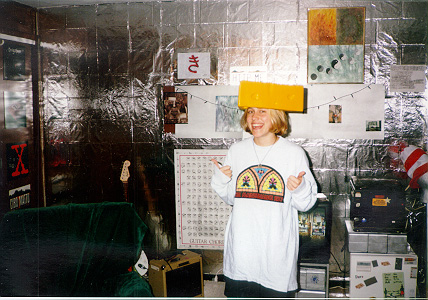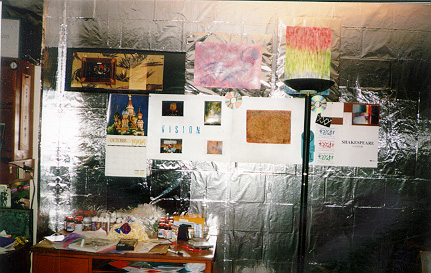When it comes to aluminum foil, I believe the possibilities are endless.
I was sitting in my huge triple room in Abel Hall on a day in August
1996. I wanted to find a way to spice things up. A roll of Reynolds Wrap
was staring me in the face. At that time, I had been to a few dances that
played exclusively techno music, and I was a computer science major.
These two influences helped me to give my room that futuristic, yet
versitale look.
 I began applying it to the wall with rubber cement. This
adhesive is easily removable by rubbing with a brush. My library
experience taught me this. If you get a quality rubber cement, it
will also dry clear, just in case you don't feel like scrubbing after the
foil removal. Little paint damage, if any results from the application
of rubber cement.
I began applying it to the wall with rubber cement. This
adhesive is easily removable by rubbing with a brush. My library
experience taught me this. If you get a quality rubber cement, it
will also dry clear, just in case you don't feel like scrubbing after the
foil removal. Little paint damage, if any results from the application
of rubber cement.
 The walls in my room take approxametly 250 sq. ft. of aluminum foil. The
ceiling took an additonal 250 sq. ft. In 1997, I decided not do do my
ceiling again. Instead, I carefully foiled my bookshelves and closets.
I had to take extra care not to damage the finish on the wood cabinets.
A minimal amount of rubber cement was applied and affixed to an
unfinished or hidden portion of the woodwork. At the end of the year
removal was quick and easy despite the painstaking application at the
beginning of the year. The woodwork required an additional 250 sq. ft
of aluminum foil.
The walls in my room take approxametly 250 sq. ft. of aluminum foil. The
ceiling took an additonal 250 sq. ft. In 1997, I decided not do do my
ceiling again. Instead, I carefully foiled my bookshelves and closets.
I had to take extra care not to damage the finish on the wood cabinets.
A minimal amount of rubber cement was applied and affixed to an
unfinished or hidden portion of the woodwork. At the end of the year
removal was quick and easy despite the painstaking application at the
beginning of the year. The woodwork required an additional 250 sq. ft
of aluminum foil.
 In Lincoln, Nebraska, a 250 sq. ft. roll of aluminum foil costs about
five dollars. A quart of rubber cement also costs about five dollars.
My total expenses in this project have been under $20 per year.
In Lincoln, Nebraska, a 250 sq. ft. roll of aluminum foil costs about
five dollars. A quart of rubber cement also costs about five dollars.
My total expenses in this project have been under $20 per year.
 Since I first used aluminum foil as a decorating tool, I have found
many other uses. My favorite is gift wrapping. One Christmas, my parents
decided to give my brother a papasan chair. I had to make the purchace
for them, and I couldn't just bring it home without being wrapped up.
The result was an interesting combination of art and functionality
Since I first used aluminum foil as a decorating tool, I have found
many other uses. My favorite is gift wrapping. One Christmas, my parents
decided to give my brother a papasan chair. I had to make the purchace
for them, and I couldn't just bring it home without being wrapped up.
The result was an interesting combination of art and functionality
